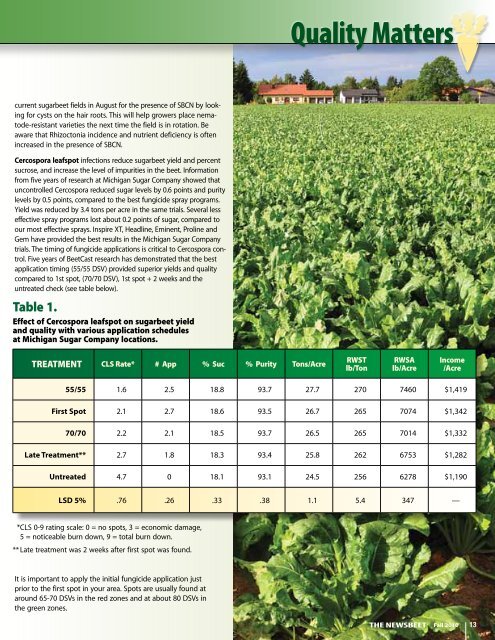Create successful ePaper yourself
Turn your PDF publications into a flip-book with our unique Google optimized e-Paper software.
current sugarbeet fields in August for the presence of SBCN by looking<br />
for cysts on the hair roots. This will help growers place nematode-resistant<br />
varieties the next time the field is in rotation. Be<br />
aware that Rhizoctonia incidence and nutrient deficiency is often<br />
increased in the presence of SBCN.<br />
Cercospora leafspot infections reduce sugarbeet yield and percent<br />
sucrose, and increase the level of impurities in the beet. Information<br />
from five years of research at <strong>Michigan</strong> <strong>Sugar</strong> <strong>Company</strong> showed that<br />
uncontrolled Cercospora reduced sugar levels by 0.6 points and purity<br />
levels by 0.5 points, compared to the best fungicide spray programs.<br />
Yield was reduced by 3.4 tons per acre in the same trials. Several less<br />
effective spray programs lost about 0.2 points of sugar, compared to<br />
our most effective sprays. Inspire XT, Headline, Eminent, Proline and<br />
Gem have provided the best results in the <strong>Michigan</strong> <strong>Sugar</strong> <strong>Company</strong><br />
trials. The timing of fungicide applications is critical to Cercospora control.<br />
Five years of BeetCast research has demonstrated that the best<br />
application timing (55/55 DSV) provided superior yields and quality<br />
compared to 1st spot, (70/70 DSV), 1st spot + 2 weeks and the<br />
untreated check (see table below).<br />
Table 1.<br />
Effect of Cercospora leafspot on sugarbeet yield<br />
and quality with various application schedules<br />
at <strong>Michigan</strong> <strong>Sugar</strong> <strong>Company</strong> locations.<br />
TREATMENT CLS Rate* # App % Suc % Purity Tons/Acre<br />
It is important to apply the initial fungicide application just<br />
prior to the first spot in your area. Spots are usually found at<br />
around 65-70 DSVs in the red zones and at about 80 DSVs in<br />
the green zones.<br />
Quality Matters<br />
RWST<br />
lb/Ton<br />
RWSA<br />
lb/Acre<br />
Income<br />
/Acre<br />
55/55 1.6 2.5 18.8 93.7 27.7 270 7460 $1,419<br />
First Spot 2.1 2.7 18.6 93.5 26.7 265 7074 $1,342<br />
70/70 2.2 2.1 18.5 93.7 26.5 265 7014 $1,332<br />
Late Treatment** 2.7 1.8 18.3 93.4 25.8 262 6753 $1,282<br />
Untreated 4.7 0 18.1 93.1 24.5 256 6278 $1,190<br />
LSD 5% .76 .26 .33 .38 1.1 5.4 347 —<br />
* CLS 0-9 rating scale: 0 = no spots, 3 = economic damage,<br />
5 = noticeable burn down, 9 = total burn down.<br />
** Late treatment was 2 weeks after first spot was found.<br />
THE NEWSBEET Fall 2010 13


